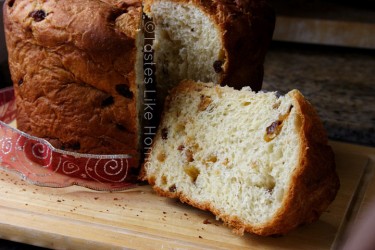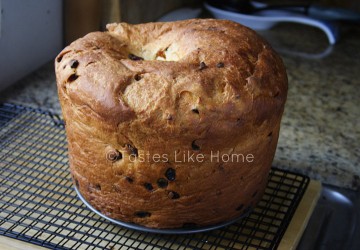Hi Everyone, The Italian sweet bread – Panettone – reminds me of the Christmas holidays. It is a sweet loaf – at Christmas sweet treats take prominence. It is peppered with colourful dried fruit – at Christmas it’s all about the colours of gold, red, green and silver. Panettone is an Italian Christmas loaf and versions of the bread can also be found in our neck of the woods – South America. Argentina, Bolivia, Brazil, Chile, Colombia, Peru, Uruguay and Venezuela all make a version of Panettone at Christmas. It is called various names Panetón, Pan de Pascua and Pan Dulce.
Holiday foods are all about tradition. Each year we pre-order meat for the holidays, set the garlic pork weeks before, have the fruits for the cake soaking in alcohol for years and so on. Just as many of our traditional Christmas preparations require a long process, so too does the traditional Panettone bread. There is a long,
One of the things about making Panettone is that tradition requires that it be baked in a tall cylindrical pan or mold to give it its signature shape and look. Because the pans are not the type that you would use regularly in your everyday baking, there are paper molds that can be bought especially to make Panettone. Let me hasten to add that unless you want to be really fussy, you don’t have to go and get any special pans or order the paper molds, a large tube pan and some parchment paper would be just fine. That’s what I used. And if you don’t have a tube pan, you can still make this bread by baking it in a large round pan or shaping the dough into loaves.
The traditional dough for the bread is not the easiest to work with as it is wet, sticky and gummy, at least at the onset. If you have a stand mixer, it makes life a whole lot easier to mix the dough. I think that’s one of the reasons that there are so many recipes or versions of recipes to make this bread because people wanted to find a way to cut down on the long process and also to find an easy way to work with the dough by hand. I don’t have a stand mixer so I worked with my hand mixer. I’ll explain more in the recipe.
Panettone is comforting with hot beverages especially hot chocolate. It’s good for dunking too. One of the best things about Panettone is the myriad of things that you do with the bread. Toasted and brush generously with butter it is so good. It’s the holidays, live a little! You can make French toast too but the pièce de résistance is making bread pudding with Panettone. I made bread pudding with half the bread for my taste-testers, and into the custard mix I added some Baileys and a few heaping tablespoons of my 4-year old Christmas fruits. I have to tell you, I got a kick out of watching them wolf down the bread pudding. And then I quickly had to say, “Christmas came early so y’all don’t even think about asking me to do this again for the holidays.”

If you’re up for some weekend baking give the recipe or both of the recipes and try. The first recipe is what I put together based on my personal taste and after analyzing several Panettone recipes. The second recipe is from the NAMICLO 2014 Cookbook-Calendar and the recipe is reprinted with their permission.
Cynthia
Panettone
(Cynthia’s version)
For this recipe you will need a 10-inch tube pan and parchment paper. Substitute with a pan of similar width and depth. You will also need a sheet pan upon which you will rest the tube pan to bake the bread.
To prep the pan, cut a large piece of parchment paper that can be inserted around the insides of the pan. The paper when cut and inserted should be 4 – 5 inches above the rim of the pan.
Brush the bottom of the pan, the tube and the sides with the parchment paper with oil and set aside.

INGREDIENTS
½ cup unsalted butter, room temperature or softened
¾ cup sugar
3 eggs, room temperature
1 tablespoon orange zest (you can use lime or lemon also)
½ teaspoon salt
1 ½ teaspoons vanilla essence
¾ cup warm whole milk (115 – 120 degrees F)
3 ½ teaspoons instant yeast
4 cups all purpose flour
1 ½ cups combined dried fruit (golden raisins, brown raisins, currants, candied citrus peel)
½ cup rum (optional)
2 tablespoons melted butter (salted or unsalted)
DIRECTIONS
1. Cream the butter and sugar until pale. If using a mixer, 3 – 4 minutes.
2. Add the eggs one and a time to butter-sugar mixture and blend well.
3. Add zest, salt, essence, milk and yeast and mix well.
4. Add the flour 1 cup at a time until all has been added, you may need to scrape the sides of the bowl to get bits of dried flour. Mix the dough mix until it comes together, it will a little sticky; mixt for 6 – 8 minutes You will notice that some of the dough sticks to the sides of the bowl, that is okay, what you want to ensure is the ingredients are mixed together and form a mass.
5. Transfer the dough to a large oiled bowl, cover and let rise in a warm, draft-free place for 2 hours or until doubled in size.
6. While the dough is rising, add the fruits and rum (if using) to a bowl and warm in a microwave for 30 seconds. Let the fruit and rum sit until the alcohol is absorbed. Toss it a few times to ensure all the fruit gets some of the alcohol. When the fruits have absorbed most or all of the alcohol, pat them gently with a paper towel and set aside.
7. Dust a work surface with flour and transfer the dough on to the work surface. Gently knead the fruits into the dough. Do not over knead, you just want to get the fruits incorporated into the dough. Let the dough rest for 10 minutes.
8. Poke a hole into the center of the dough and transfer it to the prepped baking pan. Cover and let rise for 1 hour in a warm, draft-free place.
9. Remove all the racks from your oven except one. Place the rack on the bottom shelf of the oven; this is to give the bread enough room to rise as it bakes. Preheat the oven to 350 degrees F.
10. Brush the risen dough with the melted butter and transfer the pans to the oven. Bake for 35 – 40 minutes or until a skewer inserted into the middle comes out clean (test close to the tube).
11. Remove the loaf from the oven and let cook in the pan for 5 minutes then turn out onto a wire rack to cook.
NOTES
● There are lots of websites that suggest turning the bread upside down to cool so that it does not collapse on itself. I cooled mine right side up just as it was baked and it did not collapse. However, it is important to remove the bread from the pan after the time specified in the recipe and let it cool on a rack. If it is left in the hot pan, the texture of the bread could be altered.
● If you do not have a stand mixer but you do have a hand mixer, you can still make this bread. I did it with a hand mixer. Here’s what to do. Once you have finished using the beaters to cream the butter and sugar and mix in the other ingredients, change to the dough hooks. As you add the flour, work on a low speed and move the hand mixer around the bowl to knead the dough. Be sure to scrape down the sides of the bowl as you go along.
Panettone
(NAMILCO)
Re-printed with permission
INGREDIENTS
1 tablespoon dried active yeast
1 cup lukewarm water
4 tablespoons white sugar
2 eggs, room temperature
½ cup low-fat plain yogurt
1 teaspoon vanilla extract
1 tablespoon grated lemon zest
¼ teaspoon salt
500g Thunderbolt All-purpose flour (4 cups)
1/3 cup currants
1/3 cup sultanas
1 tablespoon icing sugar
Melted butter (to brush, optional)
DIRECTIONS
1. In a medium bowl, combine yeast, water and white sugar. Cover and let stand for 10 minutes, or until foamy. Add eggs, yogurt, vanilla extract, lemon zest and salt. Mix well.
2. Stir in Thunderbolt All-purpose flour a little at a time until dough forms into a manageable ball. Turn out on to a lightly floured surface and knead for 5 to 10 minutes, adding flour as necessary, until dough is soft and pliable but not sticky.
3. Place dough in a large, lightly greased bowl, cover with a clean tea towel and let rise in a warm place until doubled in size, about 1 hour. Lightly grease a round 20cm (8”) cake tin. In a small bowl, toss dried fruit with icing sugar. Punch down dough, transfer to floured surface and knead in the fruit.
4. Form dough into a ball, place in tin. Cover loosely with the tea towel and let rise for 30 minutes. (Loaf will rise about the tin sides.) Brush with melted butter if desired. Meanwhile, preheat oven to 180 degrees C (350 degrees F). Bake for 45 minutes or until loaf is golden brown and a skewer inserted in the centre comes out clean.




